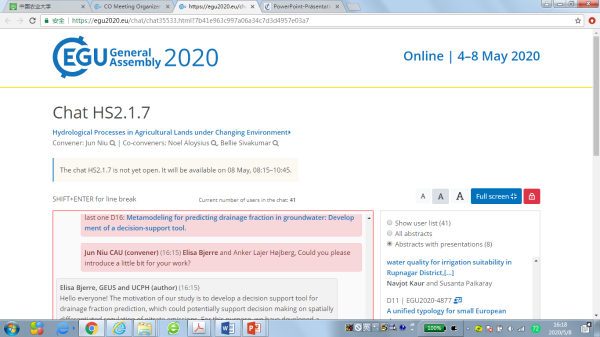European Geosciences Union (EGU) General Assembly is one of the most influential conferences in geosciences. Each annual meeting brings together more than ten thousand scientists and researchers from all over the world. This EGU conference was held from May 4 to 8, 2020 (CEST). The conference cannot be held in Vienna, Austria as planned, which was held in the online format.
Professor Jun Niu from the Center of Agricultural Water Research in China, Associate Professor Noel Aloysius from the University of Missouri as well as Professor B. Sivakumar from the Indian Institute of Technology Bombay, jointly convened the HS2.1.7 session (Hydraulic Processes in Agricultural Landscape Changing Environment). A total of 19 abstracts and 9 online materials were received in the Session, which were proposed by professors or scholars from University of Copenhagen, Université Laval, Universität Koblenz-Landau, University of Southampton, Technical University Darmstadt, Indian Institute of Technology Roorkee, Indian Institute of Science Bangalore, Latvia University of Life Sciences and Technologies, Middle East Technical University, Indian Institute of Technology Bombay, Indian Institute of Technology Bombay, and Geological Survey of Denmark and Greenland, as well as senior engineer Zhang Baozhong and Han Songjun from China Water Conservancy and Hydropower Research Institute, Ma Ying, associate research fellow of Institute of Geosciences and resources of Chinese Academy of Sciences, Sun Huaiwei, associate professor of Huazhong University of science and technology, and Shi Haiyun, associate professor of South University of science and technology.
The study topics cover Modelling the impacts of cranberry farms on the hydrologic regimes of the Bécancour River watershed in Québec, Canada; A unified typology for small European rivers; Assessment of groundwater and surface water quality for irrigation suitability in Rupnagar District, Punjab, India; Variability assessment of Irrigation Requirement for winter wheat cropping under changing climate; Effects of prospective climate change on pasture productivity in the Italian Alps; Improving dryland crop simulation by assimilating soil moisture and vegetation data; The effects of flooding and drought on water quantity and quality in agricultural drainage systems and streams in Latvia; Effects of temperature and water stress on agricultural productivity in a semi-arid irrigation system under changing climate; A recursive approach to long-term prediction of monthly precipitation using genetic programming: case of the Three-River Headwaters Region; Changes of growing degree days in the main maize producing area of China during past years; Metamodeling for predicting drainage fraction in groundwater: Development of a decision-support tool; Spatiotemporal variability of potential evaporation in Heihe River Basin influenced by irrigation; Estimation of stomatal conductance using crop water stress index based on the thermal image at a leaf scale; Estimation of wheat yield using remotely sensed and modeled data over Turkey, effectively displaying the new progresses and research results in the field of hydrological process simulation and application in agricultural lands under changing environment.

At the beginning of the meeting, the author needed to upload the summary and demonstration materials (PPT, poster, etc.). If participants were interested in a report, they only needed to have a Copernicus account to participate in the discussion, and the EGU organizer opened a text-based chat channel for each report online. At 08:15-10:45 (CEST) on May 8, according to the submission sequence of the meeting report, the venue gave each reporter 15 minutes to discuss with each other. A total of 45 participants from China, Latvia, Denmark, Canada, Germany, the United Kingdom and Turkey raised very specific questions about the content of the report and realized online interactive exchanges. There were 198 text discussion records in the whole session.

In addition, Liu Liu, associate professor from the Department of Hydraulic Engineering, also made an online report on the spatial and temporal characteristics of drought and its response to climate change in the southeast of the Qinghai Tibet Plateau, and participated in HS2.4.1 session (Hydrological extremes: from droughts to floods).